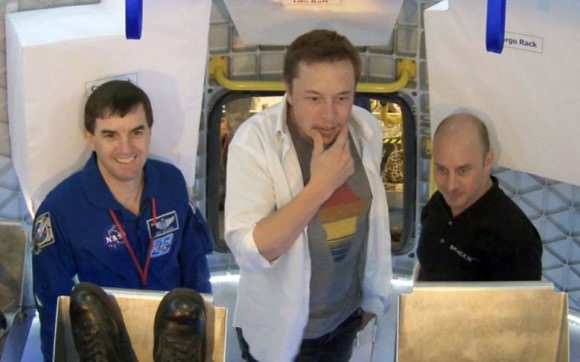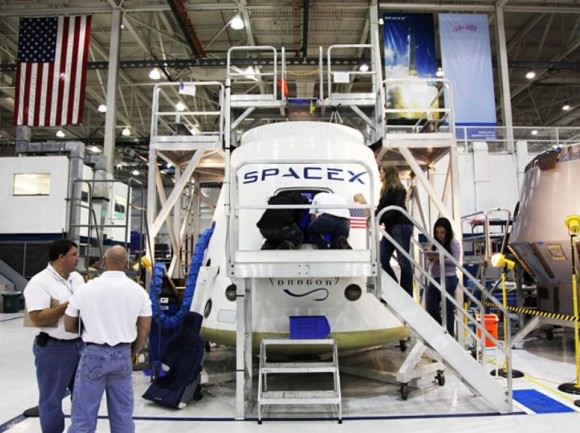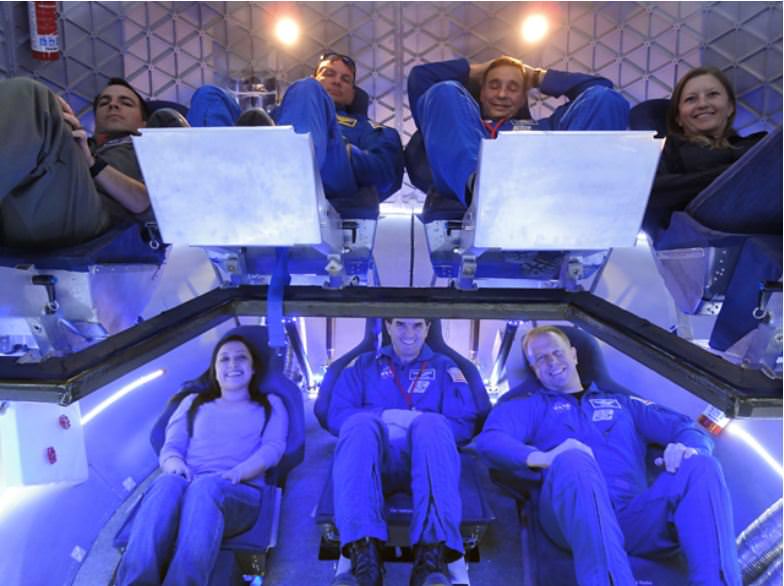[/caption]
So much for the idea that space capsules are cramped and can only carry a limited crew. SpaceX revealed a prototype for their new crew cabin design, as they conducted a joint daylong review with NASA of the Dragon crew vehicle layout. In this configuration, the Dragon will be able to carry a crew of seven, the same number the space shuttle could carry. Using a Dragon engineering model equipped with seats and representations of crew systems, they were able to get assessments and feedback from engineers and four NASA astronauts on interior amenities such as lighting, environmental control and life support systems, displays, cargo racks, and the all important seating system. The evaluators participated in human factors assessments which covered entering and exiting Dragon under both regular and emergency (that’s ‘off-nominal’ in NASA-speak) scenarios, as well as reach and visibility evaluations.
See more images from the review, below, along with a video from the initial tests of the SuperDraco engines that will power the launch escape system.
Plus, as a heads-up, SpaceX CEO Elon Musk will be on the US television show “60 Minutes” on Sunday, March 18, 2012. You can see a preview here, (which includes a touching scene of Musk talking about his heroes) and check your local listings here.

Even with all seven crewmembers in their seats, there is enough interior space for three additional people to stand and assist the crew with their launch preparations — or for the CEO to kibitz with the crew.

The seven seats mount to strong, lightweight supporting structures attached to the pressure vessel walls. Each seat can hold an adult up to 1.95 meters tall (6 feet 5 inches) and weighing 113 kg (250 lbs), and has a liner that is custom-fit for each crewmember.


Looks more comfortable than flying Southwest. How sad is that?
The tickets are more too. Guess you’re paying for the leg room.
Ha. I hope they have good activated carbon filters in the capsule. (“No sir, it wasn’t a comment on your take off procedures! It was a comment on this morning’s breakfast.”)
Just kidding, it looks terrific! I can’t wait to April 30th (the “small launch window” stated launch date), even if its “just” a COTS demonstration and not the ISS commercial crew or crew/cargo combinations.
Sadly, US pork congress critters are doing their best to delay commercials by project financial starvation.
At least until SLS can do its first manned launch sometime 2019-21 and look like a viable “ISS backup”. Right, at 1.5 billion US $ a launch it will be back right in the ball park of STS launch cost.
Hate to be a pest but, is the “recent comment” list still missing you?
Long live Elon Musk, and may his power continue to grow! The ignorance of the American masses will be blinded from the eyes of history by his glorious deeds!
Save the pics from SpaceX’s site and the file names say “DragonRider.”
Cool.
|’m glad I watched the Musk video, the guy’s passion was plain to see. I hope he gets even stinkier rich, pour encourager les autres.
Hope Obama doesn’t find new ways to tax him and spread his wealth around.
“GOD SPEED” Elon……….
GO! Space-X!
Great progress by SpaceX, way most advanced of the options to restore US human spaceflight capability. The strategy of a small affordable booster for human rated flight and work on making it re-usable.
The only sad thing is that this was not done 40 years ago with Saturn I and Saturn V. Just imagine where we could be if the proposals to make the first stage of Saturn V re-usable had been worked on instead of scrapping it.
Go SpaceX your strategy is great, design simple and test it and develop more advanced concepts based on proven hardware. Starting with Falcon 1 the Falcon 9 then Dragon Cargo then Crew and Falcon Heavy. Next is re-using the first stage then second satge, such vision and progress it is awasome.
“Just imagine where we could be if the proposals to make the first stage of Saturn V re-usable had been worked on instead of scrapping it.”
But for what purpose? We stopped making the Saturn V because we stopped doing the things that required them…not the other way around. (The fact that we didn’t even use up all the Saturns we had, tends to prove that. I’ve walked around one of the unflown ones in Houston myself.) First-stage re useability would be worth it, only if you expected seriously *more* launches.
SpaceX however, knows its current market demand, and if it can out-price the competition, does anticipate more…
The main reason for stopping Saturn was the cost, and the replacement shuttle was supposed to offer affordable access to space. But like all things trying to be all things to all people the shuttle failed at everything. Being more expensive, less reliable and not as safe with less lift capacity than the system it replaced. I know there are lots of people who like the shuttle, and it was a great machine but it did not meet the primary reason for moving avay from Saturn boosters and that is the cost of expendible rockets was too high for frequent use.
If Saturn I and V had been developed incrimentaly like SpaceX is doing with the Falcon Family history would be different and we would not need SpaceX now.
But that is history and so can not be changed all we can do is hope for the best in the future and say Go SpaceX.
You know, there just might be enough room to swing a medium tailed cat, although it’s not recommended…unless of course they’re thinking of running more wheel-of-cheese missions.
You know, there just might be enough room to swing a medium tailed cat, although it’s not recommended…unless they’re thinking of running more wheel-of-cheese missions.